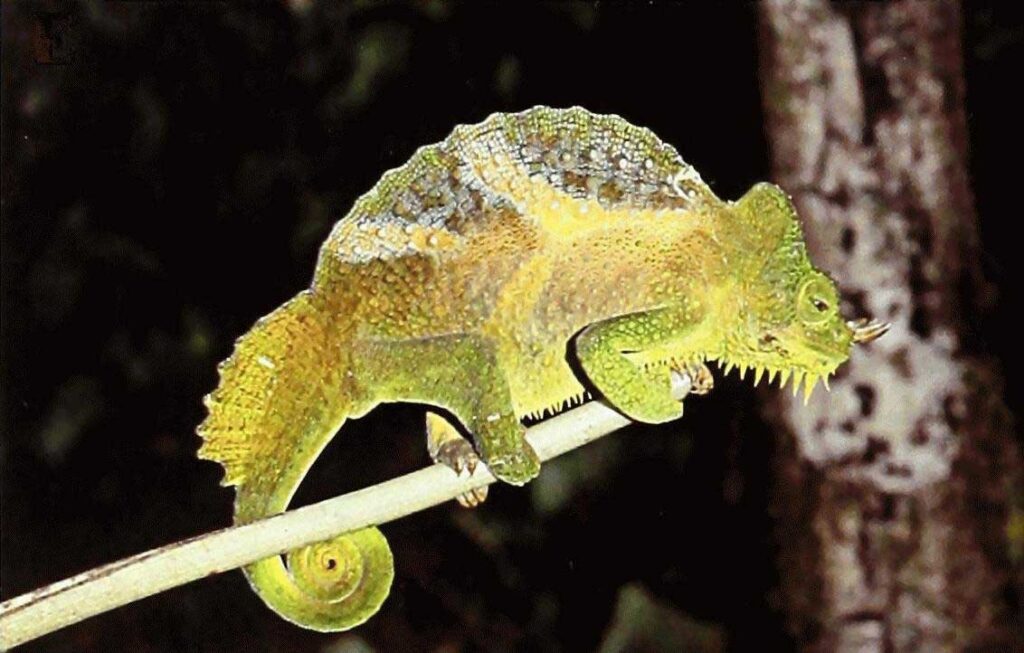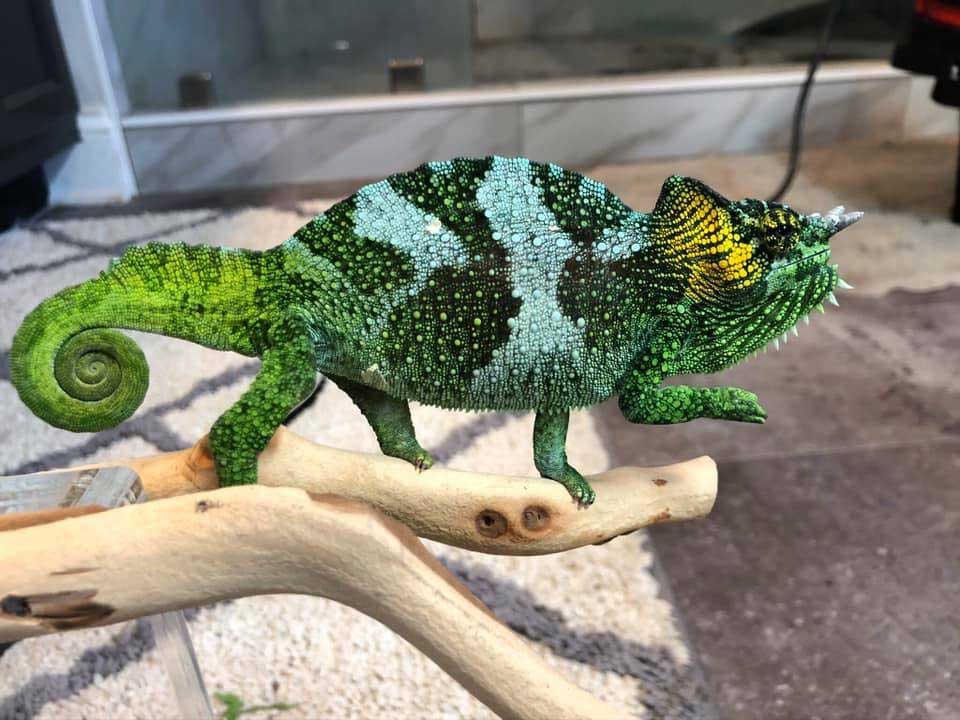
Content |
|---|
Origin / Distribution
The Four-horned chameleon It was first described by the naturalist Gustav Tornier in 1899. There are three subspecies, including the nominal.
- Trioceros quadricornis quadricornis ( Tornier, 1899) – Southern four-horned chameleon.
- Trioceros quadricornis eisentrauti ( Mertens, 1968) – Eisentraut's chameleon
- Trioceros quadricornis gracilior (Böhme amp; Klaver, 1981) – Northern four-horned chameleon
The Four-horned chameleon (Trioceros quadricornis) only found in some land areas of Cameroon and eastern Nigeria; its range includes the western highlands, the bamboo massif, Mount Manengouba, the oku massif, the Bakossi mountains, including Mount Kupe, and the Obudu Plateau in Nigeria. In particular, the subspecies Trioceros quadricornis eisentrauti is endemic to the Rumpi Hills in Cameroon.
Characteristics / Appearance
Like many other chameleons, the Four-horned chameleon it has a prehensile tail and simple claws on its toes. Usually, has four protruding horns, but sometimes two with up to four adjacent reduced horns are present;adults usually grow to 25 to 35 cm long. The Four-horned chameleon male has a prominent hemipenal bulge and gular beard, while some females have a horn or even two horns at the tip of their snout.
Habitat
In general, the Four-horned chameleon has a presence extension of 13.300 km2 and an inferred occupation area of 1.000 km2. The species is mainly associated with relatively intact montane forests with little human activity, where it has a relatively restricted elevation range (1150 to 2400 m). Research suggests this likely reflects competition with other chameleon species rather than physiological tolerances.. The type locality of the species is Monte Manegouba in Cameroon
Behavior
The species feeds almost exclusively on arthropods..
Reproduction: puts up 14 eggs.
Incubation period between 130-160 days at 18-25°C. Temperatures should not exceed 25°C.
Life expectancy: a few 7 years.
Threats to the species
State of conservation ⓘ |
||
|---|---|---|
 Vulnerable ⓘ
(UICN)ⓘ
Vulnerable ⓘ
(UICN)ⓘ
| ||
The main threat to this species is deforestation.. Agricultural development extends to the 1.700 m altitude near the village of Nsoung on Mount Manengouba, and the forest on the southeast slope of the mountain is rapidly disappearing. In 1995, forest degradation on the western slope of Mount Kupe had reached 1.200 m above sea level, due to selective logging for firewood and construction materials. So, future encroachment of human activities on the slope may pose a threat to this chameleon, which depends on a largely pristine forest and, therefore, likely to be at risk from forest degradation or clearing. Deforestation for cultivation and the burning of nearby grasslands to renew pasture for cattle threaten the species in much of its range..
Due to its small and fragmented distribution area and the numerous threats that weigh on the population, the Four-horned chameleon It is classified as vulnerable by the International Union for Conservation of Nature.
The "Four-horned chameleon" in captivity

Of the three subspecies, T. quadricornis quadricornis, T. quadricornis gracilior and T. quadricornis eisentrauti. The T. q. quadricornis is the most common, but the gracilior not uncommon. The T. quadricornis eisentrauti, on the other hand, not known (far as I know) that is in captive collections. It is even difficult to find images of the subspecies.
It is not a pet suitable for beginners.
The terrarium
terrarium size: individual storage is recommended. It is possible to keep the animals in pairs, but always pay attention to size and furnishings.
For single breeding: A terrarium of at least 100 x 60 x 120 cm..
The cages/flexarios they are just as suitable. Chameleons love fresh air..
Temperature
During the day approx.. 20-25°C, local heating up to approx.. 30-32°C. Go down to at least 15°C at night. Better still lower. If a cool cellar is available, you can also spend the night there.
Humidity
The humidity in the terrarium should range between 80-100%. In the morning and evening, spray the terrarium with warm water. But, Please, do not spray the animal.
Lighting and temperature
Daylight fluorescent tubes and/or light bulbs.
To obtain sufficient UV radiation, We use a solar light 75 watts for hobbyists. Get a surrounding heating of about 25-27 °C and local heating up to 32 °C at the highest point of the terrarium. In this case, an additional daylight lamp is not necessary..
Substrate
For us, pine bark and forest leaves have given good results, but it can be terrarium sand… The 30% of the terrarium soil must be kept moist at all times. The leaves of the forest serve as living food. to the piglets, for example, they like to crawl under, the leaves are moved by the animals and the chameleon can naturally search and observe the prey and then hunt it on its own.
Decoration terrarium
Lots of climbing opportunities, branches should not be too thick or slippery and should be easy to grip with feet.
Privacy screen for the rear and side walls. In summer, we take a flexo to the garden.
For planting we use Ficus benjamini and ivy, bamboo and, of course, a trough made by ourselves.
Food
house crickets, mealybugs, cockroaches, two-spotted crickets, zophobas, meal worms, wax worms, etc.
In summer, they go to a secluded meadow armed with a net and collect everything that crawls and flies. But it's better to do without roadside critters. We don't want to poison it!
Regular mineral and vitamin supplements are also indispensable in this case.
They only eat fruits and vegetables to cover their water needs.
The sprayed and dripping leaves are gladly used as a water source.
Buy one "Four-horned chameleon"
These Cameroonian chameleons ultra rare they are highly prized within the reptile community for their incomparable horns, its high dorsal crest, its coloration and scarcity.
Its price in the exotic animal market is around 200 EUR.
Videos "Four-horned chameleon"
|
|
|
|---|
Alternative names:
1. Four-horned chameleon, Eisentraut’s chameleon (English).
2. Caméléon à quatre cornes, Chamaeleo quadricornis (French).
3. Vierhörniges Chamäleon, Eisentraut-Chamäleon, Vierhornchamäleon (German).
4. Camaleão de quatro chifres, Camaleão de Eisentraut (Portuguese).
5. "Camaleón de cuatro cuernos", Camaleón de Eisentraut, Camaleón cuadricorne (español).